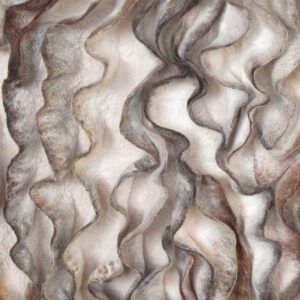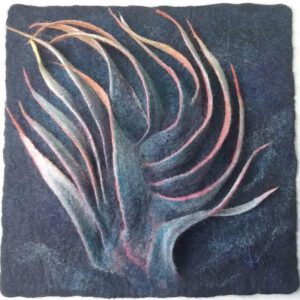Workshops early 2026 (with PDF worksheets, VIDEOS and live ZOOM meetings)
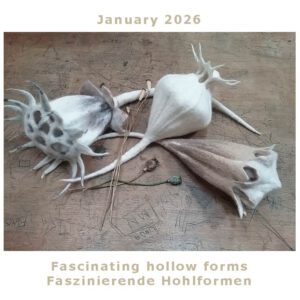
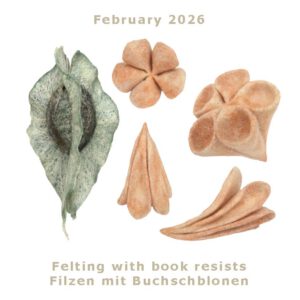
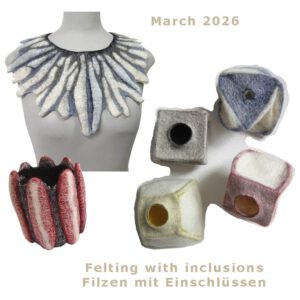
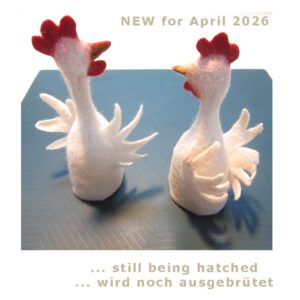
My online workshops are addressing feltmakers with prior knowledge. You should at least be familiar with the foundations of felting and have some practical experience. With each project we’ll take a close look at specific techniques that will enrich your felting practice and inspire you to create new work.
Most classes are taking place over 2 days during one weekend, with a 3 hours live ZOOM session each day, supported by VIDEO and PDF instructions for you to continue working independently at home. Videos will stay accessible for 2 more months after each class. There’s 3 groups available for different time zones (thur/fri in English for EU/AU/NZ and sat/sun in German and in English for EU/Americas)
The NEW MASTERCLASS is scheduled with 3 days.
*** Meine Onlinekurse richten sich an Filzerinnen mit Vorkenntnissen. Ihr solltet zumindest mit den Grundlagen des Filzhandwerks vertraut sein und etwas praktische Erfahrung mitbringen. Jedes Projekt ist so eingerichtet, daß wir spezielle Techniken genauer unter die Lupe nehmen, die Eure Filzpraxis bereichern und Euch zu neuen Arbeiten inspirieren sollen.
Alle Kurse finden an einem Wochenende statt. An 2 Tagen treffen wir uns 3 Stunden live über ZOOM, ergänzt durch VIDEO und PDF Anleitungen, nach denen Ihr selbständig zu Hause weiterarbeiten könnt. Die Videos bleiben nach dem Kurs 2 weitere Monate verfügbar. Für unterschiedliche Zeitzonen sind 3 Gruppen eingerichtet, Sa/So morgens in Deutsch und Do/Fr morgens sowie Sa/So abends in Englisch.
Der NEUE MASTERCLASS KURS geht über 3 Tage.
Get inspired for future classes in the students gallery/ Laß Dich für künftige Kurse inspirieren in der Teilnehmer Galerie!
2026: The HOLLOW FORMS SERIES offers you three complementary courses. They can be booked individually (139 €) or all three as a package for 375€. Working on a variety of rather small objects, this is a good chance also for those with little felting knowledge. The projects are not large and difficult to felt, but we’ll take a close look at details and discover a variety of options, tipps and tricks./ Die SERIE HOHLFORMEN bietet Euch 3 einander ergänzende Kurse. Sie sind einzeln buchbar (139 €) oder alle 3 als Paket zu 375 €. Da wir an vielseitigen, eher kleinen Objekten arbeiten, ist dies auch eine gute Gelegenheit für diejenigen, die noch wenig Erfahrung mit dem Filzen haben. Die Projekte sind nicht groß und schwer zu bearbeiten, aber wir werden uns die Details genau ansehen und eine Vielzahl von Möglichkeiten, Tipps und Tricks entdecken.
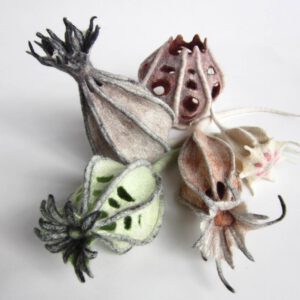 N° 26/01 Fascinating hollow forms en miniature / Faszinierende Hohlformen in Miniatur – part I (139 €)
N° 26/01 Fascinating hollow forms en miniature / Faszinierende Hohlformen in Miniatur – part I (139 €)
Gr. 1 Jan 15/16, 2026 in English 10 a.m.-1 p.m. (CET, Berlin time = suitable for Europe, Australia/NZ) (7 places available)
Gr. 2 Jan 17/18, 2026 in Deutsch 10 -13 h (6 Plätze frei)
Gr. 3 Jan 17/18, 2026 in English 06-09 p.m. (CET, Berlin time = suitable for Europe, America) (waiting list)
In nature we can find a variety of interesting shells, pods and capsules, a rich source of inspiration for hollow felted forms. We can learn a lot from them in terms of architecture and stability, important features in feltmaking, too. In a series of small scale poppy seedpods we will practise especially a very fine and precise layout of fibres. Playing with thick and thin amounts of wool in different sections we can change shapes considerably and achieve a variety of interesting forms, even starting from the same, relatively simple resist!
*** In der Natur finden wir eine Fülle von interessanten Schalen, Gehäusen und Kapseln, die ein spannendes Studienobjekt und Anregung für Filzarbeiten sein können. An ihnen läßt sich Vieles in Sachen Architektur und Stabilität beobachten, was uns auch beim Filzen sehr nützlich ist. In einer Reihe von kleinen Mohnkapseln üben wir vor allem sehr feines und gezieltes Auslegen der Wolle. Ändern wir das Verhältnis von dick und dünn ausgelegten Partien, können wir überraschend verschiedene Formen aus derselben, relativ einfachen Schablone modellieren!
⇒ For reservation send an e-mail
Please make sure to type in your correct email address and write a message, what you would like to know.
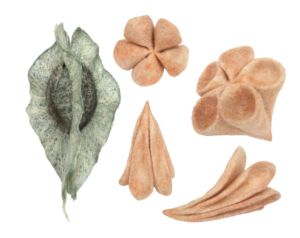 N° 26/02 Felting with book resists / Filzen mit Buchschablonen – part II (139 €)
N° 26/02 Felting with book resists / Filzen mit Buchschablonen – part II (139 €)
Gr. 1 Feb 12/13, 2026 in English 10 a.m.-1 p.m. (CET, Berlin time = suitable for Europe, Australia/NZ) (8 places available)
Gr. 2 Feb 14/15, 2026 in Deutsch 10 -13 h (8 Plätze frei)
Gr. 3 Feb 14/15, 2026 in English 06-09 p.m. (CET, Berlin time = suitable for Europe, America) (waiting list)
After starting with simple, flat resists for a hollow form we will now go one step further and explore the potential of so-called book resists. These provide enormous possibilities of creating more complex 3d shapes with multiple segments or objects of higher volume that can be pleated, turned inside out and transformed into unexspected spatial shapes. For practising, we will start with a simple 3-pages-version and make a winged seedpod, then take the challenge of a 5-pages-resist with surprising possibilities for transformation. An eye-opener for further experimenting with book resists and applications of them in wearable as well as fine felt art.
*** Nachdem wir eine einfache, flache Schablone für Hohlformen benutzt haben, gehen wir nun einen Schritt weiter und erkunden das Potential von sog. Buchschablonen. Diese eröffnen spannende Möglichkeiten, um komplexere 3d Formen mit mehr Segmenten anzulegen oder Objekte mit mehr Volumen, das gefaltet oder eingestülpt werden und zu überraschenden räumlichen Gebilden umgeformt werden kann. Zum Üben beginnen wir mit einer einfachen Schablone mit 3 Seiten und filzen eine geflügelte Samenkapsel. Danach wagen wir uns an eine 5-Seiten-Schablone und erleben interessante Verwandlungsmöglichkeiten. Eine bereichernde Anregung, wie man Buchschablonen weiterdenken und vielseitig für Kleidung wie auch gefilzte Kunstobjekte einsetzen kann.
⇒ For reservation send an e-mail
Please make sure to type in your correct email address and write a message, what you would like to know.
 N° 26/03 Felting with inclusions / Filzen mit Einschlüssen – part III (139 €)
N° 26/03 Felting with inclusions / Filzen mit Einschlüssen – part III (139 €)
Gr. 1 March 5/6, 2026 in English 10 a.m.-1 p.m. (CET, Berlin time = suitable for Europe, Australia/NZ) (9 places available)
Gr. 2 March 7/8, 2026 in Deutsch 10 -13 h (9 Plätze frei)
Gr. 3 March 7/8, 2026 in English 06-09 p.m. (CET, Berlin time = suitable for Europe, America) (4 places available)
In this course we want to explore how to make use of old pieces of felt, giving them a new life and use inclusions for attractive relief surfaces or sculptural effects. All of us will have a stock of old felting experiments, unfinished projects or accidents and mostly it’s still valuable materials that don’t deserve to end up in the bin. You will see how you can incorporate even solid felt pieces into a new work, as a special surface feature, rigid stability element or even form changer in the shrinking process. On the first day we’ll practise on a small piece of jewelry, on the second day we’d have a look at transforming hollow bodies. A stimulation for re- or upcycling and making the best of available resources.
*** In diesem Kurs erkunden wir Möglichkeiten, wie alte Filzstücke zu neuem Leben erweckt und in neuen Arbeiten Verwendung finden können, für attraktive Relief-Oberflächen oder auch interessante Hohlformen. Alle von uns besitzen wahrscheinlich einen Vorrat alter Filzexperimente, unvollendeter oder verunglückter Projekte. Diese sind noch wertvolles Material und meist zu schade, um im Mülleimer zu landen. Ihr werdet lernen, wie auch feste Filzstücke in neue Werke gut haltbar eingearbeitet werden können, als Oberflächenstruktur, stabiles Formelement oder für Umformungseffekte im Schrumpfprozeß. Am ersten Tag üben wir an einem kleinen Schmuckstück, am zweiten geht es ans Umformen von Hohlkörpern. Eine Anregung zum Re- oder Upcycling und zur sinnvollen Verwendung unserer Materialressourcen.
⇒ For reservation send an e-mail
Please make sure to type in your correct email address and write a message, what you would like to know.
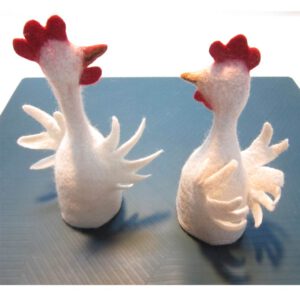
N° 26/04 …………???
For April there will be a new topic, still being hatched… /
Im April gibt es ein neues Thema, das wird noch ausgebrütet…
Gr. 1 April 09/10, 2026 in English 08-11 a.m. (CET, Berlin time = suitable for Europe, Australia/NZ)
Gr. 2 April 11/12, 2026 in Deutsch 10 -13 h
Gr. 3 April 11/12, 2026 in English 06-09 p.m. (CET, Berlin time = suitable for Europe, America)
GENERAL INFORMATION ONLINE WORKSHOPS
All online workshops require at least basic knowledge in felting and are designed to fit comfortably into one weekend, allow 5-6 working hours daily. (Participants from the Pacific region can start thursday/friday afternoon and have the weekend ahead to complete their project.)
We will start together in a live meeting of about 3 h via Zoom until you feel confident with continuing independently. This way you have time to complete the task of the day at your own pace, until meeting online again the next day and doing the next steps together. Videos of the felting process are used in class and stay available to you for 2 more months on Zoom, complemented by printable PDF handouts. I will not record the actual Zoom meeting, but saved all videos in the cloud beforehand. This way I can guarantee a good video quality and we can enjoy the live class and focus on our work without being distracted by technical issues.
You’re welcome to join us for a final show-and-tell (usually on the following thursday) where we can have a look at all your new creations and discuss last remaining questions.
For reservations please send an e-mail with your name, country, e-mail, tel and the respective workshop No.
Please check hours for your time zone.
Within usually 24 h I will respond and send you a reservation together with details about the class and technical requirements. Booking and payment will be done about 1 month before each class, this way we can avoid return transfers in case you cannot participate. With incoming payment you’ll receive your booking confirmation and material list, the zoom link and PDF handouts follow short before the class.
Group size is limited to 10 participants.
*** ALLGEMEINE INFORMATIONEN ONLINE KURSE
Alle Kurse setzen zumindest Basiswissen im Filzen voraus und sind so geplant, dass sie bequem in ein Wochenende passen, rechnet mit ca. 5 – 6 Stunden täglich. Wir beginnen gemeinsam mit einem live Treffen von ca. 3 h auf Zoom und anschließend habt Ihr Zeit, die letzten Einzelheiten des Tages in Ruhe selbständig abzuschließen. Am nächsten Tag sehen wir uns wieder im virtuellen Filzatelier und gehen gemeinsam die nächsten Schritte. Wir verwenden Videoaufnahmen aller Arbeitsschritte im Kurs. Diese bleiben weitere 2 Monate in der Zoom Cloud für Euch zugänglich und Ihr erhaltet auch eine PDF Anleitung zum Ausdrucken. Ich zeichne nicht den laufenden Kurs auf, sondern habe alle Videos vorab in der Cloud gespeichert. So bekommt Ihr garantiert gute Videoqualität und wir können uns während des Zoom Meetings entspannt auf’s Arbeiten konzentrieren, ohne von technischen Details (und mitunter Tücken!) abgelenkt zu sein.
Jeweils am darauffolgenden Donnerstag könnt Ihr Euch zu einer Anschlußrunde einloggen, wo wir gemeinsam die neuen Kreationen bestaunen und evtl. verbliebene Fragen besprechen können.
Für Reservierungsanfragen, sende bitte eine email mit Deinem Namen, Land, Email-Adresse, Tel.nr. und der gewünschten Kurs-Nr. (evtl. auch die Sprache, falls Du in eine der englischsprachigen Gruppen möchtest)
In der Regel erhältst Du innerhalb 24 h eine Reservierungsbestätigung mit allen wichtigen Details zum Kurs und technischen Voraussetzungen. Die endgültige Buchung und Bezahlung mache ich erst ca. 1 Monat vor dem Kurs, so vermeiden wir unnötige Rücküberweisungen, falls jemand dann doch nicht teilnehmen kann.
Mit eingehender Zahlung wird Dein Platz verbindlich bestätigt und Du bekommst eine Materialliste, Zoom link und PDF Anleitung folgen kurz vor dem Kurs.
Die Gruppen sind auf 10 TeilnehmerInnen begrenzt.
The topics below will come again later… / Die u.g. Themen kommen später mal wieder auf den Plan…
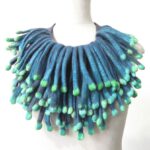
Matchstick necklace / Streichholz Collier (139 €)
In this workshop we want to felt a fancy piece of jewelry in which dense tufts of sticks with colored tips are connected to form a necklace. I have named it the matchstick necklace.
When laying out the wool, we will pay particular attention to the composition of materials and fibre direction, in order to create a stable felt and firmly enclose the colored section at the lower edge. This allows us to cut many narrow strips later, with their upper end securely anchored in a collar. Everything is felted again to seal the cuts and give the matchsticks a perfect finish. If you don’t like it quite so opulent or would like to practise on a simpler model first, you may want to start with fewer tiers. Of course, you can choose your favourite colors.
*** In diesem Kurs wollen wir einen originellen Halsschmuck filzen, in dem dichte Büschel von Stäbchen mit farbigen Kuppen zu einem Collier verbunden werden. Ich habe es Streichholz Collier getauft.
Beim Auslegen werden wir besonders auf Materialzusammensetzung und Faserrichtung achten, damit ein stabiler Filz entsteht, bei dem auch der farbige Abschnitt am unteren Rand gut haltbar eingeschlossen ist. Das erlaubt uns später viele schmale Streifen zu schneiden, deren oberes Ende fest in einem Halsband verankert ist. Alles wird nochmals nachgefilzt , um die Schnitte zu versiegeln und die Hölzchen schön auszuformen. Wer es nicht ganz so opulent mag oder zunächst an einem einfacheren Modell üben möchte, kann auch mit weniger Ebenen beginnen. Eure Wunschfarben könnt Ihr natürlich selbst auswählen.
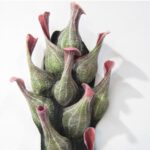 Sculpture with pitcher plants / Wandskulptur mit Kannenpflanzen (139 €)
Sculpture with pitcher plants / Wandskulptur mit Kannenpflanzen (139 €)
Many of you have been asking for more sculptural felt projects – so here we’ll continue with a new seamless 3d creation, a bark fragment inspired by pitcher plants. Felt develops quiet a strong presence in a room. The relatively small dimensions of this sculptural piece (65x30cm) will not at all diminish its effect and allow us to cope with it during one weekend. As always, I included some technical themes to enrich your felting skills:
You will learn how to add organic forms to a solid background felt in a fluent and natural way. We will practise a painterly use of colors that will help to increase the spatial effect. Another important aspect are combination of materials and well planned fiber direction to achieve a beautiful natural shape and sufficient stability for the pitchers to stand upright. Last not least, fulling the felt to a firm consistency will give it the perfect finish.
*** Viele von Euch haben Interesse an weiteren skulpturalen Filzprojekten bekundet – hier geht es also weiter mit einer neuen nahtlosen 3d-Kreation, einem Rindenfragment, inspiriert von Kannenpflanzen. Filz entwickelt eine starke Präsenz im Raum. Die relativ geringen Abmessungen (65x30cm) unseres Übungsstücks schmälern seine Wirkung keineswegs und sind an einem Wochenende zu bewältigen.
Wie immer habe ich einige technische Themen einbezogen, die Eure Fertigkeiten bereichern sollen: Ihr werdet lernen, wie organische Formen fließend und natürlich in einen festen Filzhintergrund eingefügt werden können. Wir üben den malerischen Einsatz von Farben, um die räumliche Wirkung zu verstärken. Ein weiterer wichtiger Aspekt ist die Kombination von Materialien und eine gut geplante Faserführung, um eine schöne, natürliche Form und ausreichend Stabilität zu erzielen, damit die Kannen aufrecht stehen können. Zu guter Letzt wird der Filz durch Walken zu einer festen Konsistenz gebracht, die ihm das perfekte Finish verleiht.
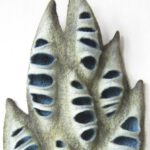 Fossil leaf sculpture / Wandskulptur Blattfossil (139 €)
Fossil leaf sculpture / Wandskulptur Blattfossil (139 €)
In this workshop I’d like to introduce another way of creating an impressive structure for a sculptural wallhanging. This time we’d assemble a group of hollow chambers and incorporate them in a larger item. They can be opened later and manipulated manually to form an organic seamless felt object. The silhouette of the sculpture will only arise from the arrangement of all individual parts.
We’d pay special attention to fiber combination and directions to connect all parts securly and prepare the material for specific shaping and deformations. With a well planned use of color through all layers we can even increase the dimensional effect. As an example I developed this fossil leaf project for you. It will allow us to discuss and practise all working steps included and enable you to apply the technique to a variety of individual felt works in the future.
*** In diesem Kurs möchte ich eine andere Möglichkeit vorstellen, wie eine eindrucksvolle Struktur für ein Wandobjekt erzeugt werden kann. Wir wollen diesmal eine Gruppe von Hohlräumen vorbereiten, diese zu einer grösseren Form zusammensetzen und nahtlos miteinander verbinden. Die Kammern werden später geöffnet, umgeformt und von Hand in eine organische Form modelliert. Die Konturen der Skulptur werden sich erst aus der Anordnung aller Einzelteile ergeben.
Wir schauen uns speziell das Zusammenwirken verschiedener Materialien und die Faserführung an, um alle Teile sicher zu verbinden und das Filzgut gezielt für Umformungen vorzubereiten. Auch der Einsatz von Farben durch alle Schichten hindurch will gut durchdacht sein und kann die räumliche Wirkung erheblich verstärken. Als Beispiel habe ich ein Blattfossil für Euch vorbereitet, an dem wir alle Arbeitsschritte erläutern und üben können. Die erlernten Techniken könnt Ihr künftig vielseitig in eigenen Filzarbeiten anwenden.
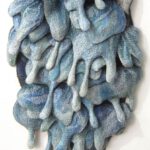 Cascade – 3 days masterclass for experienced felters / Kaskade – Masterclass 3 Tage für erfahrene Filzerinnen (189 €)
Cascade – 3 days masterclass for experienced felters / Kaskade – Masterclass 3 Tage für erfahrene Filzerinnen (189 €)
The cascade project will demonstrate how my sculptural wall hanging “melt” was created. However, we will work on a slightly smaller scale so that we can manage the size of the object in the course and still get to know and practise the most important technical aspects. By combining 3-dimensional felt components and the painterly use of wool fibers we can achieve an impressive spatial effect. We will have a close look at suitable wool types, consistency and function of the different layers and fibre directions. A mixture of different wool colors on the surface, as if they were brushstrokes of a painting, will give the picture depth and liveliness. When finally placing the individual levels on the background, we’ll try to find an interesting rhythm in order to create a perspective and dynamic movement.
Our project is a little more extensive and challenging this time and includes 3 course dates. On the first day (late July) you will get an overview and start to prepare the individual levels of the cascade. You’ll then have a few weeks to make enough individual parts for your work, take your time to think about its final shape and maybe, individual design features.
Then we’ll meet again (early September) for a weekend with 2 course days, assemble the individual parts, add final details and complete the sculpture.
***Das Kaskadenprojekt soll Euch zeigen, wie mein skulpturaler Wandbehang „melt“ entstanden ist. Wir werden allerdings in etwas kleinerer Dimension arbeiten, um die Größe des Objekt im Kurs bewältigen zu können und dabei trotzdem die wichtigsten technischen Grundlagen kennenzulernen und zu üben. Im Zusammenspiel von 3-dimensionalen Filzkomponenten und dem malerischen Einsatz der Wollfasern, lässt sich eine eindrucksvolle räumliche Wirkung erzielen. Dazu schauen wir uns geeignete Wolltypen, die Konsistenz und Funktion der verschiedenen Schichten und Faserrichtungen genau an. Eine Mischung verschiedener Wollfarben auf der Oberfläche, als wären es Pinselstriche eines Gemäldes, wird dem Bild Tiefe und Lebendigkeit verleihen. Beim Aufsetzen der einzelnen Ebenen auf den Hintergrund wollen wir versuchen, einen spannenden Rhythmus zu finden, um Perspektive und dynamische Bewegung in das Objekt zu bringen.
Unser Vorhaben ist diesmal etwas umfangreicher und anspruchvoller und beinhaltet 3 Kurstermine. Am ersten Tag (Ende Juli) verschaffen wir uns einen Überblick und beginnen, die einzelnen Ebenen der Kaskade vorzubereiten. Danach habt Ihr einige Wochen Zeit, ausreichend Einzelteile für Euer Werk herzustellen und in Ruhe die endgültige Form Eures Werkes und evtl. individuelle Gestaltungsformen zu durchdenken.
Anschließend treffen wir uns wieder (Anfang September) für ein Wochenende mit 2 Kurstagen, setzen die Einzelteile zusammen, ergänzen letzte Details und stellen die Skulptur fertig.
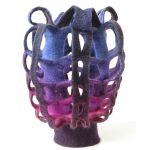 Diversity – discovering new species in felt / Artenvielfalt in Filz entdecken (139 €)
Diversity – discovering new species in felt / Artenvielfalt in Filz entdecken (139 €)
Experimenting and playing is a very important part of the creative process and implies an incredible potential for new discoveries and creative solutions. It is a rich source for learning more about our soft sculptural material, wool, and techniques we can use to transform it into a piece of art.
In this workshop we will take off for an exiting expedition: use only one type of resists, assemble them into a series of hollow chambers and explore different possibilities to develop felt objects from this starting point. How far can we go with them? With changing positions of resists, different ways of cutting, shrinking and transforming we can create an amazing variety of forms. Of course, we will take care to prepare a durable fibre combination in our layout that is made to survive all these experiments in good shape!
Cutting into the felted structure in particular, opens up new insights and perspectives. It often exposes inner parts of the object and/or layers in the cuts and allows interesting 3-dimensional shapes to unfold. They may resemble seedpods, leaves or insects, can become a surface structure, sculptural wall piece, a light object or even a wearable piece of felt art! – Welcome and enjoy a playful, experimental workshopl!
*** Experimentieren und Spielen im kreativen Schaffen bergen ein unglaubliches Potenzial für neue Entdeckungen und kreative Lösungen. Hier können wir viel über unser weiches skulpturales Material Wolle und die Techniken lernen, mit denen wir sie in ein Kunstwerk verwandeln können.
In diesem Workshop begeben wir uns auf eine spannende Entdeckungsreise: verwenden nur eine Art Schablonen, setzen sie zu einer Reihe von Hohlkammern zusammen und erkunden verschiedene Möglichkeiten, um daraus Filzobjekte zu entwickeln. Wie weit können wir mit ihnen gehen?
Mit wechselnden Positionen der Schablonen, durch Schneiden, Schrumpfen und Umformen können wir eine erstaunliche Vielfalt an Formen schaffen. Natürlich werden wir darauf achten, eine haltbare Faserkombination vorzubereiten, die all diese Experimente unbeschadet übersteht!
Insbesondere Schneiden in die gefilzte Struktur eröffnet neue Einblicke und Perspektiven. Es legt oft innere Teile des Objekts und/oder Schichten in den Schnitten frei und lässt interessante 3-dimensionale Formen entstehen. Sie können Samenschoten, Blättern oder Insekten ähneln, zu einer Oberflächenstruktur, einem skulpturalen Wandstück, einem Lichtobjekt oder sogar einem tragbaren Filzkunstwerk werden!
Willkommen zu einem spielerischen, experimentellen Workshop!
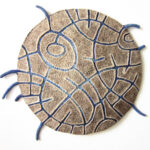 Felted shield wall panel / Gefilztes Wandschild (139 €)
Felted shield wall panel / Gefilztes Wandschild (139 €)
In this workshop you are going to create a convex felted wall shield with decorative line patterns. You will learn how to make a solid, substantial felt object and design its surface in a very individual way. A variety of inspirations can be found in maps, mazes, cave paintings or contemporary art, letters and symbols, or you can just invent your own drawings.
We’ll have a close look at the so-called cracked-mud-technique and complement it by some specific details to achieve a clear and well felted structure. Optionally, you may want to add some extensions to the basic form and we’ll see how to connect them to the shield’s body in a firm and fluent way.
*** In diesem Kurs werdet Ihr ein gewölbtes Wandschild mit dekorativen Linienmustern erschaffen. Ihr lernt, wie man eine dickwandige, stabile Form filzen und ihre Oberfläche ganz individuell gestalten kann. Inspirationsquellen können sehr vielfältig sein: Stadtpläne, Labyrinthe, Höhlenzeichnungen oder moderne Kunstwerke, Schriftzeichen oder Symbole. Natürlich könnt Ihr auch eine eigene Zeichnung entwerfen.
Wir schauen uns die sogenannte Schollentechnik genauer an und ergänzen sie um einige spezielle Details, um ein klares und gut gefilztes Muster zu erhalten. Optional könnt Ihr Erweiterungen über den Rand hinaus anbauen und lernt, wie man diese fest mit der Grundform verbindet und einen fließenden Übergang schafft.
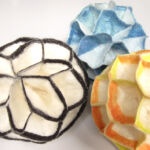 (Un)folding – Honeycomb structures / (Ent)faltungen – Wabenstrukturen (139 €)
(Un)folding – Honeycomb structures / (Ent)faltungen – Wabenstrukturen (139 €)
In this workshop we want to explore possibilities of building 3d foldable felted objects. With a set of basic resists we will see how they can be combined, aligned or interlaced with each other to achieve different shapes and flexibility of an object. It’s a playful, experimental approach but requires quiet some precision in layout. A good opportunity to have a close look at material combinations, direction of wool fibres, position, order and overlap of resists – technical details that can be very helpful in many different situations in feltmaking, for example for jewellery, hats or decorative objects.
*** In diesem Kurs erkunden wir Möglichkeiten, wie man faltbare 3d Strukturen in Filz aufbauen kann. Mehrere Einzelschablonen können unterschiedlich kombiniert, aufgereiht oder miteinander verschränkt werden, um so verschiedene Formen oder Flexibilität zu erzeugen. Ein spielerischer, experimenteller Kurs, der jedoch einige Genauigkeit beim Auslegen erfordert. Eine gute Gelegenheit, Materialkombination und Faserrichtung sowie Platzierung, Reihenfolge und Überlappung der Schablonen genau unter die Lupe zu nehmen – technische Details, die in vielen anderen Situationen beim Filzen sehr hilfreich sein können, z.B. für Schmuck, Hüte oder dekorative Raumobjekte.
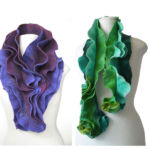 Ruffled collar / Gekräuselter Lamellenkragen – collars part I (139 €)
Ruffled collar / Gekräuselter Lamellenkragen – collars part I (139 €)
This collar with a relatively simple basic form disposes of several lamellae which can be stretched and draped in smoothly ruffled layers. We will practise a targeted layout for an elastic type of felt in a seamless 3d version. Even with only little felting experience you can dare to make a 3-4 lamellae collar and would receive a beautiful and attractive result. The faster or more experienced of you may want to add some extra resists and integrate additional partial layers or petals (right picture).
*** Dieser Kragen mit relativ einfacher Grundform besitzt mehrere Lamellen, die sich dehnen und in weich gekräuselten Lagen drapieren lassen. Wir üben gezieltes Auslegen für einen elastischen Filz und nahtloses Filzen räumlicher Objekte. Schon eine einfache Variante mit 3-4 Lamellen sieht toll aus und ist mit wenig Vorkenntnissen gut zu bewältigen. Wer es sich zutraut, kann noch einige kleine Schablonen für zusätzliche Zwischenlagen oder Blütenblätter integrieren (rechtes Modell).
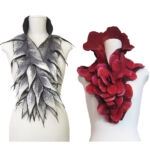 Feather collar / Federkragen – collars part II (139 €)
Feather collar / Federkragen – collars part II (139 €)
For a collar with feathers or petals we will build a 3d structure of many small elements on the surface of a basic form. We will focus on a precise and fine layout of all single „ingredients“, clear contours and a harmonic position of all feathers on the base. With a complex composition like this we should take good care when starting the felting process itself, to keep control of all components included and make sure they would all connect properly.
You should have some prior experience working with resists (or, to make it easier, begin with a version with not too many feathers).
*** Für einen Feder- oder Blätterkragen bauen wir eine größere Anzahl kleiner Elemente auf einer Grundform auf und erzeugen so 3-dimensionale Oberflächen. Wichtig sind hier präzises Auslegen, klare Konturen und eine harmonische Anordnung aller Federn. Beim Filzen ist nun schon etwas mehr Vorsicht geboten, um die vielen Komponenten unter Kontrolle zu behalten und sicherzustellen, daß sie sich fest miteinander verbinden.
Ihr solltet etwas Erfahrung in der Arbeit mit Schablonen mitbringen (oder beginnt zur Übung vielleicht mit etwas weniger Federn).
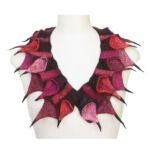 Calyx collar / Collier mit Blütenkelchen – collars part III (139 €)
Calyx collar / Collier mit Blütenkelchen – collars part III (139 €)
Our 3rd and most challenging version is dealing with a composition of a number of small hollow forms. With the help of templates we will prepare many small cones or cups and combine them into a seamless necklace or collar. This requires an especially fine and clear layout. You will practise how to work precisely with fine amounts of fibres and small-scale patterns.
A project for experienced felters (or recommended in combination with No. 23/09 and 11 to develop your skills step by step).
*** Als dritte und anspruchsvollste Variante beschäftigen wir uns hier mit der Kombination von Hohlformen. Mittels Schablonen erzeugen wir kleine Höhlungen oder Kelche, die alle separat vorbereitet und anschließend zu einem Collier / Kragen zusammengesetzt werden. Hier ist besonders feines und klares Auslegen gefragt, was Euch die Gelegenheit gibt, den Umgang mit feinen Wollschichten und zierlichen Formen zu üben.
Ein Projekt für geübte Filzerinnen! Wer nur wenig Vorkenntnisse hat, kann mit Kurs 23/09 und 11 beginnen und seine Fertigkeiten schrittweise vervollkommnen.
All 3 collar workshops as a bundle for 375€ *** Alle Kragen Kurse im Paket für 375 €
From class 1 to 3, we will gradually increase the complexity and level of our projects. You may consider participating in all 3 workshops (at a discount price) and take the chance to improve and expand your skills step by step. Some weeks in between allow further practising or experimenting with the new technique.
But you may also book a single class (139 €). Students who already took 2 parts of the collar series, can upgrade to the bundle price. Please add a short note in your reservation.
*** Von Kurs 1 bis 3 steigert sich der Schwierigkeitsgrad schrittweise und Ihr habt somit die Möglichkeit, alle 3 Kurse (zum ermäßigten Preis) zu belegen und so Eure Fertigkeiten nach und nach auszubauen. In den Wochen dazwischen bleibt Zeit zum Üben oder Experimentieren mit der neuen Technik.
Es kann aber auch nur ein einzelner Kurs (139 €) gebucht werden. Wer schon 2 der Kragenkurse belegt hat, kann auf den ermäßigten Preis upgraden. Bitte macht einen kleinen Vermerk in Eurer Anmeldung.
Get inspired for future classes in the students gallery/ Laß Dich für künftige Kurse inspirieren in der Teilnehmer Galerie!
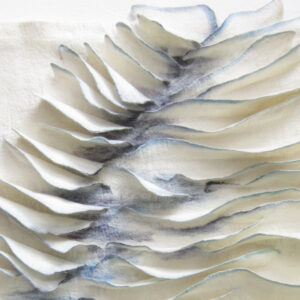
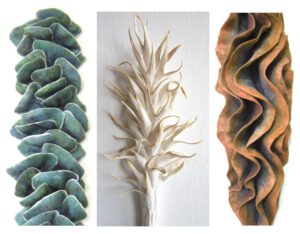 November 23-29, 2025
November 23-29, 2025